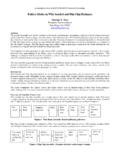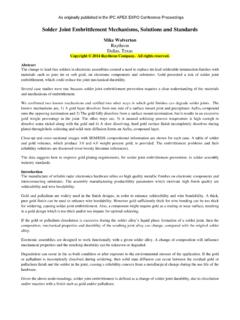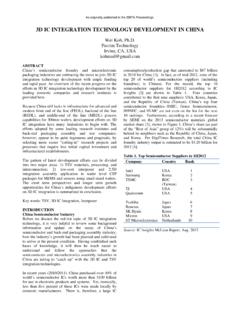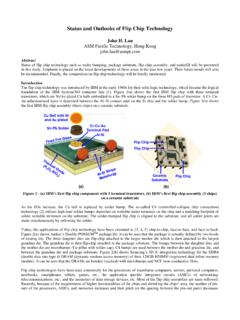Transcription of Flip Chip Package Qualification of RF-IC Packages
1 As originally published in the IPC APEX EXPO Proceedings. flip chip Package Qualification of RF-IC Packages Mumtaz Y. Bora Peregrine Semiconductor San Diego, Ca. 92121. Abstract Quad Flat Pack No Leads (QFNs) are thermally enhanced plastic Packages that use conventional copper leadframe with wire bonded interconnects.. These leadless components provide an advanced packaging solution that reduces board real estate, with improved electrical and thermal performance over traditional leaded Packages . The move towards finer pitch is resulting in using flip chip bumps as interconnects on an interposer substrate and packaging as QFN. [1]. The QFN devices commonly known as BTC (bottom terminated components) are attractive due to their low cost per I/O, performance and low profile; they are also a challenge for assembly due to their low to zero standoff height.
2 Successful assembly yields and solder joint reliability requires careful selection of substrate materials, fluxes, component plating finishes, controlled reflow processes and flatness of Package and PWB. [2]. This challenge is enhanced with the transition to lead free reflow as the higher peak reflow temperatures results in more thermal and CTE mismatch between Package and PWB. Wire bonded leadframe Packages are typically plated with 100%. Matte tin or NiPdgold on the solderable terminations. Interposer substrate is typically plated with Electroless nickel /gold for solderability of terminations. War page characteristics of interposer substrates have to be evaluated to minimize stress on the flip chip bumps.
3 Reflowing Packages with flip chip bump interconnects requires a good balance of substrate / Package material sets and controlled reflow profiles to ensure proper melt of the bump interconnects and solder joint reliability thru subsequent reflow processes at assembly facilities. The paper reviews the Qualification efforts for solder interconnects on interposer substrates, X-ray and X-sectional analysis of Packages and process optimization efforts to improve reliability of the interconnects Introduction flip chip interconnects are in demand for consumer electronics as these Packages shorten the signals , reduce inductance and improve functionality of these Packages as compared to the wire bonded Packages .
4 These Packages are commonly known as LGA (Land Grid Array) Packages . To ensure reliability of these Packages in high volume SMT assembly production requires careful selection of critical commodities like IC Packages and PWBs. SMT assembly yields depend on good quality components, solder paste print processes and oven reflow profiles. This has become more critical in lead free reflow due to higher peak reflow temp. And narrow process windows. Proper storage and handling controls of components and process controls in production are necessary for good yields and reliability. The paper summarizes the Qualification of solder and copper interconnects. Package construction analysis was conducted to assess integrity of die attach, molding and plating processes.
5 X-section and SEM/EDX analysis, and reliability test results for thermal cycling tests are presented including continuous improvement efforts at subcontract locations. Substrate Selection and Design The substrates used for interposer Packages are typically 2 layers thin laminate approximately 150- 200 micron thick BT. resin with 100 micron drilled visa for layer interconnects. The typical pad pitch is 200 microns with the option of having solder mask defined or non-solder mask de fined pads. Figure 1 shows the bottom side of the substrate pads with the terminations that solder to the board. Figure 2 shows an X-Ray image of a typical leadframe wire bonded Package .
6 As originally published in the IPC APEX EXPO Proceedings. Figure 1. Subtrate bottom side terminations Figure 2. Wirebonded QFN Package flip chip Bump Options The bumping options require evaluation as there are many different metallurgies that can be used for flip chip bumping depending on the application and use environement for commercial products, Hi-Reliability products etc. The most common bump material used is eutectic or lead free solder. Other materials used are copper bumps or pillars with solder cap to attach to the substrate pad or gold stud bumps for some hi-reliability applications. The early process development work was done using daisy chain dies with lead free solder by product.
7 Figure 3 shows a X-section of solder bump and Figure 4 shows an example of Copper bump in X-section. Figure 3 - Solder Bump Figure 4 Copper Bump Assembly Process The assembly process requires proper optimization of die placement on the interposer pads to get an optimized solder profile. Die placement is done using automated placement equipment. A tacky flux is sprayed on the substrate to facilitate the wetting of the solder bump. In some cases, the bottom one third of the bumps are dipped in flux and then placed on the substrate for reflow. Flux spray process on the substrate appears to give more uniformity and facilitates wetting of the bump. X-Ray Inspection Inspection after placement is done using X-Ray to ensure that thebump is aligned to the pad.
8 A first article inspection is conducted using X-Ray , prior to die placement on the balance of the lot and the necessary adjustments are made to align the die. Reflow Profile Package was reflowed using a lead free solder profile for both solder bump and copper bump using a peak reflow temp of 250C . Multiple reflow profiles were evaluated until the heating and the cooling rate was sufficiently controlled to get an optimum bump profile post reflow. Profiles that are not optimized can result in open bumps post reflow or post thermal shock. X-Ray of the reflowed bumps is also conducted toensure proper melt of the bumps. Figure 5 shows the X-Ray image post reflow. As originally published in the IPC APEX EXPO Proceedings.
9 Post Reflow X-sectioning was conducted to understand the solder joint profile, alignment, presence or absence of voids also to evaluate the grain structure of the solder joint. Voids can get trapped at the bump to substrate interface and cause assembly issues. Generally acceptable criteria for voids is less than 30% of the bump diameter. Figure 6 shows X-section of a reflowed Package Figure 5- X-Ray image Post-Reflow Figure 6- X-section of a reflowed solder bump Reflow profile evaluations were also conducted on the copper bump to optimize the reflow profile and minimizes stress on the reflowed bump. Open bumps can occur on the reflowed side or at the die to bump interface due to coefficient of thermal expansion (CTE) mismatch and substrate warpage during reflow.
10 Figure 7 shows the X-section of the copper bump post reflow Figure 7- Copper bump Post Reflow Overmolding: Package is overmolded with a mold compound and post mold cured at 175C for 6 hours. Proper selection of molding materials is essenttial to minimize impact on electrical properties. Multiple runs were conducted to optimize the cure profile, mold pressure, cure time , temp. etc. Figure 8 shows the X-section of an overmolded Package Mold Compound Solder mask for mask defined pads. Figure 8 X-section of overmolded Package As originally published in the IPC APEX EXPO Proceedings. Reliability Testing A prerequisite to Package reliability testing is moisture pre-conditioning to classify Package MSL class and ensure that it survives reliability test post moisture soak.











